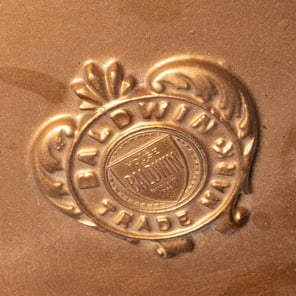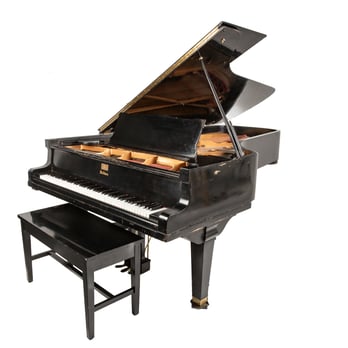An Embodiment of the American Piano's Golden Age
When Sam Green filed a lawsuit to retrieve the piano from the New York Academy of Art, he argued that the Baldwin Concert Grand Model B piano represented the finest in American piano construction. Indeed the 1900s to the 1940s were considered the Golden Age of piano making in the United States. “The 1929 Baldwin piano is the embodiment of the best practices in piano construction in its era,” declares Kendall Ross Bean, a composer, concert pianist, and piano historian who, along with Karen Earle Lile, owner of Piano Finders, provided crucial expertise in tracking down the provenance and authenticating the Lennon–Ono-Green-Warhol piano.
 Sam Green was correct in his assessment of the piano during his lawsuit and his claim that this Baldwin has extraordinary value. Green was certainly an expert in the value of fine things–he not only discovered and nurtured talent in the pop art world but was also a seasoned curator and collector of a large range of valuable items, from rare paintings to vintage cars and of course, pianos.
Sam Green was correct in his assessment of the piano during his lawsuit and his claim that this Baldwin has extraordinary value. Green was certainly an expert in the value of fine things–he not only discovered and nurtured talent in the pop art world but was also a seasoned curator and collector of a large range of valuable items, from rare paintings to vintage cars and of course, pianos.
The time-honored and labor-intensive process that built the 1929 Baldwin that Lennon bought is all but lost to modern piano-making. In the late 20th and early 21st century, the traditional method of piano construction was automated and expedited. The United States was no longer the center of piano building, but much of this work was moved overseas to Asia. In 2000, Baldwin declared bankruptcy and was purchased by the guitar company Gibson.
Although much of the fascination surrounding the Lennon-Ono-Green-Warhol piano centers on the exalted artists whose hands passed over its keys, the piano itself, from the moment John Lennon purchased it in 1978, represents the grandeur of the Golden Age of American piano making.
 Since Bartolomeo Cristofori a harpsichord rebuilder invented the first pianoforte for the Florentine court of the Grand Prince of Ferdinando de Medici in 1700, the evolution of the piano ushered in new eras not only in music but also in cultural history and design.
Since Bartolomeo Cristofori a harpsichord rebuilder invented the first pianoforte for the Florentine court of the Grand Prince of Ferdinando de Medici in 1700, the evolution of the piano ushered in new eras not only in music but also in cultural history and design.
The novelty of the pianoforte was that, as its name suggested, it could be played both loudly and softly. Harpsichords in the 17th and 18th centuries were quite soft and the player had little control over the volume. Because the pianoforte could vary in its loudness and softness, it became an instrument fit for the home, church, and concert hall.
Fast-forward more than 200 years into the future when the piano became as essential a fixture in an elegant home as an exotic rug or a mahogany bookcase. These pianos, true to their name, were designed for extemporaneous tunes to delight guests after a meal or for young music students drilling their daily scales. In other words, there were plenty of pianos that were soft and subtle enough for domestic use, but there was a growing need for the ideal concert piano.
 The 1929 Baldwin Concert Grand Model B Piano which was purchased by John Lennon in 1978 was a leap in the evolution of great concert hall pianos. D.H Baldwin declared in 1890 that he would produce “The best piano that could be built”. The model he produced that year was a mere 5’ 11’’. Quite small in comparison to the Lennon - Ono - Green - Warhol model, a 9 foot long instrument with a generous soundboard that would create sufficient resonance to fill a concert hall.
The 1929 Baldwin Concert Grand Model B Piano which was purchased by John Lennon in 1978 was a leap in the evolution of great concert hall pianos. D.H Baldwin declared in 1890 that he would produce “The best piano that could be built”. The model he produced that year was a mere 5’ 11’’. Quite small in comparison to the Lennon - Ono - Green - Warhol model, a 9 foot long instrument with a generous soundboard that would create sufficient resonance to fill a concert hall.
Just a year before Lennon purchased the piano, it was rebuilt and restored to its original condition. Piano makers often rebuilt their golden era concert grands, a practice that began during World War II when most manufacturers were committed to the war effort, and to meet the demand, they shifted their focus to restoration. This explains why Lennon acquired a 1929 grand piano in mint condition.
Since Baldwin no longer manufactures concert grand pianos today, the Lennon-Ono-Green-Warhol piano marks the end of an illustrious era of piano-making in the United States. The buyer of this piano will acquire not only a storied work of art with an impressive history but a well-preserved testament to the golden era of piano construction.